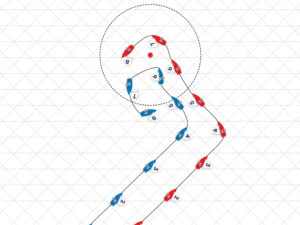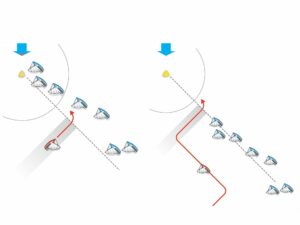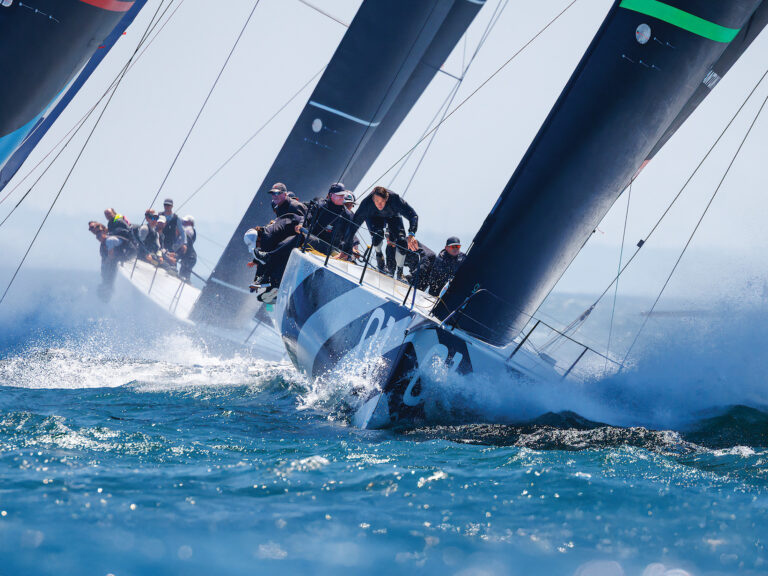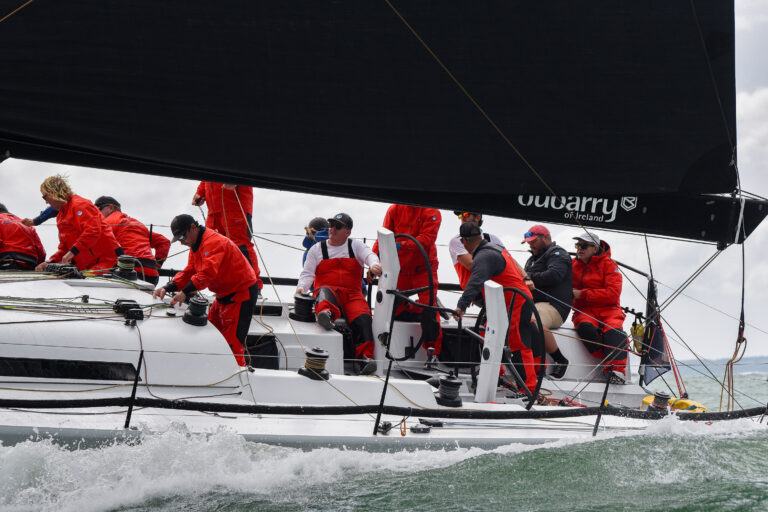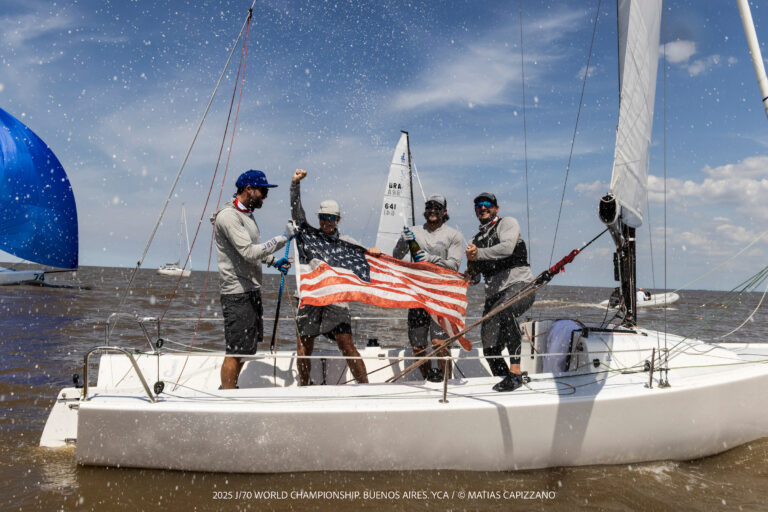I have received copies of two letters from competitors that raise questions about rules compliance. One, from Marc Fountain, appeared on the Internet in “Scuttlebutt” and a second, from H. C. Pierce, was sent to the US SAILING Racing Rules Committee. Both letters report a lack of compliance with the rules. Mr. Fountain writes, “The use of the 720-degree Turns Penalty continues to decline and the percentage of people racing without respect to the rules continues to rise.” Mr. Pierce complains that port-tack boats in his fleet are brazenly breaking Rule 10, the fundamental port-starboard rule.
My observation is that rules compliance varies widely from fleet to fleet and, even within a fleet, it can be excellent one year and then very poor two years later. Several factors may contribute to the deterioration in rules compliance within a given fleet in a particular year: 1. A few competitors refuse to admit fault and do 720-degree Turns Penalty when they break a rule. 2. Competitors refuse to take the time to protest even flagrant fouls. 3. The race committee sets courses that result in heavy concentrations of boats at the favored end of the starting line or at marks. 4. A protest committee is unwilling to dig out the facts and penalize appropriately those who break the rules, especially those who break them repeatedly. 5. A number of new competitors have not learned the rules.
Lets assume that your race committee and protest committee are doing good jobs and that your fleet members know the rules fairly well. In that case you must somehow change the behavior of those who flaunt the rules and fail to do their 720s and of those who do not protest when they are fouled.
Theres a technique for improving rules compliance which I have seen work well. Those who sail by the rules and who want to improve rules compliance should meet. Do not invite to the meeting those fleet members who repeatedly break rules. At the meeting, get the members present to agree that when theyre fouled theyll immediately hail “Protest” and, if the boats in the fleet are more than six meters (20 feet) long, fly their protest flags. Also–and this is the key to this techniques success–get an agreement from everyone at the meeting to watch out for fouls and, when they see an incident between two boats and hear the hail of “Protest” from one of the boats, to yell loudly “Ill be your witness.” I think youll be surprised how quickly rules compliance improves.
Note that the key ingredient here is social pressure. As soon as those who are ignoring the rules learn that a number of fleet members recognize what theyre doing and want it to stop, youll probably see a change in their behavior. You may not even have to hold many protest hearings. A sailor whos protested will get the message if he or she immediately hears several hails from other boats offering witness. Theyll recognize that the deck is stacked against them and probably take their 720-degree Turns Penalty rather than try to defend themselves in the protest room.
Heres an example of how this technique worked. One young dinghy sailor consistently rocked and pumped his way around the course in the prevailing light to moderate winds. He was obviously breaking the propulsion rule (Rule 42) with great regularity and scoffed when individuals asked him to clean up his act. One day several of those who had complained about this fellow met and agreed to watch him and to hail “Protest” whenever they saw him clearly breaking Rule 42. Right after the start of the first race, as he was fanning his way into the lead, four boats simultaneously hailed “Protest.” He stopped rocking for a while and then resumed it a few minutes later, at which time a second round of “Protest” hails rang out. The young sailor left the course in tears. He didnt return for a couple of weeks, but then he came out and sailed by the rules. He was welcomed back, and nothing was said about the past.
Marc Fountain complains that the rules introduced in 1997 have hurt the sport by removing onus provisions. In fact, only two onus provisions were removed in 1997–the onus involving close tacks and jibes and a rarely used onus in the tacking-at-an-obstruction rule.
The old tacking and jibing onus rule stated that a boat that tacked or jibed had the onus of satisfying the protest committee that she did so far enough from nearby boats that they could keep clear without having to change course until after the tack or jibe was completed. It was removed because it was simply too easy for a dishonest competitor to use it to disqualify an opponent. I admit that it’s now a bit more difficult to win a protest when someone tacks too close to you, but it’s hard to imagine that the sport has been hurt now that there are fewer inequitable DSQs.
H. C. Pierce complains that some aggressive skippers are flaunting the port-starboard rule. He reports that they brag, “If I’m on port and may or may not just barely be able to cross a starboard tacker, I hail ‘Hold your course!’ and go for it. If he hits me I can get him disqualified under Rule 14. If he avoids contact and protests, I’ll say it wasn’t really that close. What’s more, if the starboard boat heads up at all, I’ll claim that he broke Rule 16.”
I suggest that Mr. Pierce call a meeting of those in his fleet who would like to eliminate these aggressive violations of Rule 10 and proceed with protests as I described above. Note that the hail “Hold your course!” is not mentioned in the rules. There is no rule that requires a starboard-tack boat to hold her course if a port-tack boat is trying to cross ahead of her. The starboard boat is always permitted to change course in a direction that makes it easier for the port tacker to cross. In order not to break Rule 16 while port is crossing ahead, starboard must not change course if doing so would result in port needing to have to change her course to continue keeping clear or if it would deprive port of room to keep clear.
Heres a strategy that members of Mr. Pierces fleet can use to change the aggressive behavior he described. When one of the problem skippers is on port tack approaching a rules-abiding sailor on starboard, the starboard boat should hail “Starboard” quite loudly to call the attention of nearby boats to the developing situation. Then, when starboard is within two lengths of port, starboard should not change course until it is clear that there is risk of collision. At that point, starboard should ease sheets and bear off hard to avoid contact, while simultaneously shouting “Protest.” Nearby skippers who hear the first hail of “Starboard” should try to watch the incident and, as soon as they hear the hail of “Protest” yell to starboard that they will witness for her. Faced with this scenario, port may concede and make a 720-degree Turns Penalty. If she does not, the protest should be an easy one to win. If one skipper is protested repeatedly under Rule 10 and repeatedly provides evidence that is at odds with that given by several witnesses, then the protest committee should consider taking action under Rule 69.1 for a gross breach of sportsmanship.
E-mail for Dick Rose may be sent to rules@sailingworld.com

